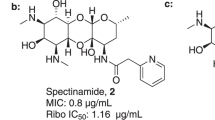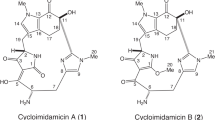Abstract.
Three pairs of related macrolide antibiotics, differing at the 11,12 position of the macrolactone ring, were compared for effects on growth rate, cell viability, protein synthesis, and 50S ribosomal subunit formation in Staphylococcus aureus cells. For each parameter measured, the 11,12 carbonate–derivatized compound was more inhibitory compared with the corresponding 11,12-hydroxy antibiotic. Substitution at the 3-position of the ring was also important in the relative inhibition observed. The degree of inhibition found in two different growth media was proportional to the generation time of the cells. Inhibition of both protein synthesis and 50S subunit formation by each drug correlated well with the inhibition of cell viability. The results indicate that closure of the 11,12-hydroxyl groups in macrolide antibiotics with a carbonate substitution generates a more effective antimicrobial agent.
Similar content being viewed by others
Author information
Authors and Affiliations
Additional information
Received: 11 January 1999 / Accepted: 9 February 1999
Rights and permissions
About this article
Cite this article
Champney, W., Tober, C. Superiority of 11,12 Carbonate Macrolide Antibiotics as Inhibitors of Translation and 50S Ribosomal Subunit Formation in Staphylococcus aureus Cells. Curr Microbiol 38, 342–348 (1999). https://doi.org/10.1007/PL00006814
Issue Date:
DOI: https://doi.org/10.1007/PL00006814




